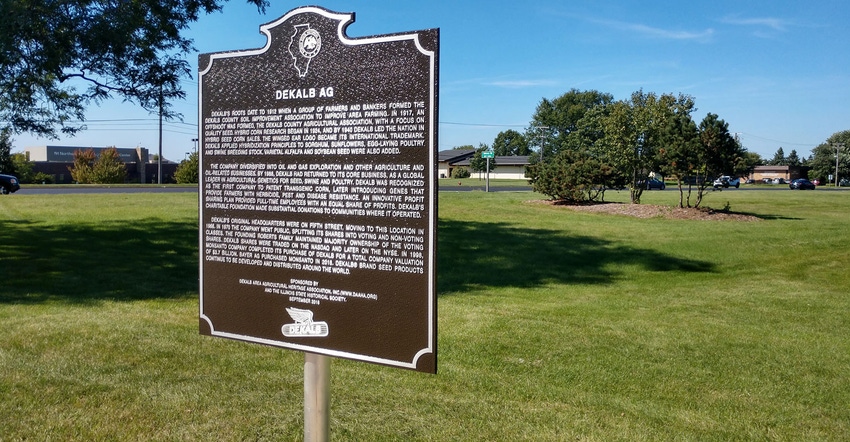September 20, 2018

New marker celebrates DeKalb Corp. at old HQ
Alumni of DeKalb Genetics Corp. gathered Tuesday to commemorate their company’s contribution to agricultural history with a new marker placed in front of their former headquarters in DeKalb, Ill., now a wellness and literacy center for Northern Illinois University.
The ninth in a series of historical markers placed throughout DeKalb County, the sign features a short summation of the company’s history. Former CEO Bruce Bickner worked on its wording along with several others who dedicated the marker Tuesday. In his dedication, he thanked the thousands of employees that have worked for the company since its start in 1912.
“In the final analysis, it’s a very large group of talented and innovative individuals that are the real ag story,” Bickner said.
The DeKalb Area Agricultural Heritage Association plans to continue adding markers to historical sites throughout DeKalb County, many of which have already been mapped and placed on three tour routes.
Governor declares 2018 harvest emergency
Gov. Bruce Rauner has declared a harvest emergency, allowing farmers and grain haulers to receive free permits to haul 10% over weight limits.
The action bridges the gap between the 2018 harvest and a new law that takes effect next year. The emergency declaration is in effect until Dec. 31 and enables crop haulers to seek free Illinois Department of Transportation permits to exceed legal maximum gross vehicle and gross axle weight limits or the vehicle’s registered gross weight, whichever is less, by no more than 10% on state and federal highways under IDOT’s jurisdiction, except interstates. Permits are issued at no charge, but route authorization numbers must be obtained every two weeks.
Got tar spot? Illinois researcher wants to know
Corn growers in northern Illinois and surrounding areas are noticing a marked increase in tar spot this year, with 30% infection rates in some fields. University of Illinois pathologist Nathan Kleczewski has been fielding daily calls and emails about the disease from concerned producers.
What does he know about how to manage the disease? “The bottom line is that we do not really know, but we are working on it and need help from producers,” Kleczewski says.
The relatively new disease was first described in Illinois near DeKalb in 2015, with additional sightings in Indiana. Since that time, the leaf disease has been detected in northern Illinois each year, but until now, infections have been sparse and have occurred late in the season, minimizing yield loss. Symptoms vary from traditional black raised bumps, to bumps with necrotic fisheye lesions, to spots on leaves that lead to blight and drydown. Hybrids may differ in susceptibility.
If you see symptoms of tar spot, please send samples to Dianne Plewa at the University of Illinois Plant Disease Clinic. The website with address and contact information is located at web.extension.illinois.edu/plantclinic.
Contact Kleczewski directly to help with variety testing at 217-300-3253 or [email protected], or on Twitter @ILplantdoc.
Stay safe in the fields
Celebrate National Farm Safety and Health Week, Sept. 16-22, by staying safe. To recognize the seven days and the beginning of harvest, Ameren Illinois offers the following seven safety tips:
1. Look up, down, side to side, and constantly scan for potential hazards. Awareness is the key to mitigating potential for a dangerous situation.
2. Always use a spotter when operating or moving equipment. A spotter can help identify hazards that may not be visible in your line of sight.
3. Remember to lower raised machinery when exiting the field, as many overhead power lines border roads.
4. Proactively call Ameren Illinois at 800-755-5000 if you notice power lines that appear to be drooping or sagging. Never try and remedy the situation yourself.
5. If equipment comes into contact with overhead lines, assume the equipment and surrounding area are energized. Remain inside the cab until Ameren Illinois arrives. Stepping out could cause your body to become the path to ground for electricity, resulting in electrocution.
6. Calling 811 before beginning any projects that require deep digging (e.g., tile plowing and setting fence posts) can reduce the potential for underground facility strikes.
7. Don’t put your mind on autopilot when operating equipment. Even though high-tech GPS units are increasingly prevalent inside cabs, GPS can’t always recognize potential hazards.
What’s special about 8,029,847?
That’s the number of registered voters in the 2016 Illinois general election, which is about two-thirds of Illinois’ 12.8 million people. The gubernatorial race is potentially record-breaking with significant self-funded campaigns ($126.8 million from Pritzker and $67.8 million from Rauner, as of Aug. 27).
You May Also Like




